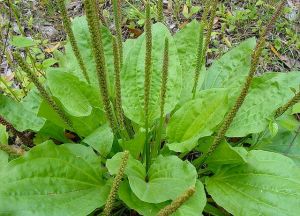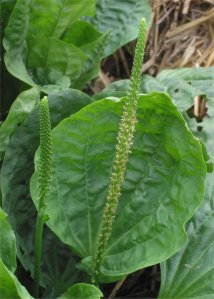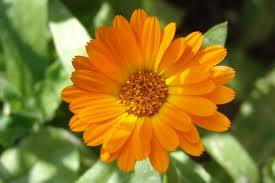Greater plantain (Plantago major) is a perennial herbaceous plant that is very common in the United States and Europe. It grows very well in compacted and disturbed soil such as along roadways and paths. The peculiar characteristic of growing in areas upset by humans led to the name of “White Man’s Footprint” in America.
This lovely plant is not only medicinal, but highly nutritious and has been used as food and medicine for millennia. It is a great source of vitamin A, C and K as well as calcium.
Mature leaves can be dried for later use in a dehydrator or by simply tying them in small bunches and hanging in a well ventilated area.
 The Properties of Plantain: (See the Herbal Terminology Post for Definitions)
The Properties of Plantain: (See the Herbal Terminology Post for Definitions)
Analgesic, Anti-Inflammatory, Astringent, Demulcent, Diuretic, Expectorant, Hemostatic
Uses for Plantain include:
Medicinal: Helps with wound healing, sores, rashes, stings, diarrhea, dysentery, bladder problems, gastrointestinal ulcers, ringworm, and hemorrhoids.
Cosmetic: Used as an astringent to tighten pores and help balance oily skin.
Energetic and Spiritual: Plantain is an herb belonging to the element of Earth and is in tune with the planetary energies of Venus. It is used to promote healing when kept around the home and helps keep negative energies at bay when carried or hung around the house.
Rubbing the feet with plantain leaves is said to invigorate the body and spirit.
Culinary: The young tender leaves can be used raw in salads, but the mature leaves become very tough and should be prepared in a similar way to spinach.
Infusion: steep 1 teaspoon fresh or dried leaves in ½ cup of water. Take 1 to 1 ½ cups a day a mouthful at a time, unsweetened. This method is useful for diarrhea, dysentery, bladder problems and gastrointestinal ulcers. This method is also great for use as a toner on the face.
Poultice: mix 1 teaspoon of fresh or dried leaves with 1 teaspoon of bentonite or kaolin and enough water to form a paste. This paste can be applied topically to help heal wounds, stings, sores, rashes and even ringworm. This method is also great as a tightening mask for the face.
If you do not have clay available, simply chew the leaves until a paste is form and spread onto the afflicted area.
Contraindications:
There are none known, but use with extreme caution during pregnancy and while breastfeeding.
Always check with a healthcare practitioner before beginning herbal treatments.
Information Pulled from:
The Herb Book by John Lust
The Master Book of Herbalism by Paul Beyerl
Cunningham’s Encyclopedia of Magical Herbs by Scott Cunningham
The Complete Illustrated Encyclopedia of Magical Plants by Susan Gregg
Notes taken on an herb walk in Boulder, CO with herbalist Cat Pantaleo
Images from Google.com







